
Choy Lee Fut
Napisano Ponad rok temu
Czyli coś w interpretacji czy to forma "wewnętrzna" czy qigong zmieniło się w ciągu kilkunastu ostatnich lat!!
Jest to podejście marketingowe, rozdzielenie kung-fu i qigong!Inni instuktorzy inne szkoły inni adepci ITD.
Inna sprawa, że definicja qigong a "forma wewnetrzna CLF" to nie to samo.Ale to dłuższy temat na dyskusję...
Napisano Ponad rok temu
BTW Maciej T napisał:
Ależ takie rozdzielenie ma mimo wszystko sens! Wielu ludzi, którzy nigdy nie zapisaliby się na CLF (starsi, schorowani itp. itd) mogą dzięki temu ćwiczyć sam qigong (np. formy "18 rąk Luohan`a, Xiao Luohan itp.). Jeżeli formy te nauczne byłyby tylko jako element systemu Choy Lee Fut, to ludzie ci nigdy nie ćwiczyli by tego qigong`uJest to podejście marketingowe, rozdzielenie kung-fu i qigong!Inni instuktorzy inne szkoły inni adepci ITD
Napisano Ponad rok temu
Ciekawe pytanieAno właśnie. Jak widzicie rozróżnienie "forma qigong" a "forma wewnętrzna"? Bo dla mnie to było to samo
Czy "forma wewnętrzna" to "forma mająca zastosowanie bojowe" ?
W CLF formy wewnętrzne to oczywiście formy mające zastosowanie bojowe, tyle że inaczej się ją ćwiczy i na inne elementy kładzie się nacisk.
Czyli jak napisałem wcześniej - MARKETINGAleż takie rozdzielenie ma mimo wszystko sens! Wielu ludzi, którzy nigdy nie zapisaliby się na CLF (starsi, schorowani itp. itd) mogą dzięki temu ćwiczyć sam qigong (np. formy "18 rąk Luohan`a, Xiao Luohan itp.). Jeżeli formy te nauczne byłyby tylko jako element systemu Choy Lee Fut, to ludzie ci nigdy nie ćwiczyli by tego qigong`u
Wg mnie taki rozdział jest ok. Oczywiście adapci CLF nie moga zapominać o Luohan`ie - też go muszą ćwiczyć
Nie ma w tym nic złego, ale jak już ktoś ze znawców na tym forum napisał "ludzie ćwiczący Tai Chi dla zdrowia, są mniej zdrowi od tych którzy ćwiczą Tai Chi dla walki" - czy coś w tym sensie
Tak samo będzie się miała sprawa z CLF
pozdrawiam
Napisano Ponad rok temu
W CLF formy wewnętrzne to oczywiście formy mające zastosowanie bojowe, tyle że inaczej się ją ćwiczy i na inne elementy kładzie się nacisk.
Dzięki, o taką odpowiedź mi chodziło.
tsailifo napisał:
Pozostałe formy wewnętrzne CLF :
1. Goon Yum Dzo Lin Jeong
2. Lohan Fok Fu Kuen
3. Fut Jeung Kuen
4. Sieh Ying Kuen
8O Nawet nie słyszałem o tych formach...
Czy to formy z przekazu mistrza Doc Fai Wong`a? I jaką drogą szedł przekaz "z góry"?
Napisano Ponad rok temu
A nasz główny przekaz idzie od starszego z synów mistrza Chan Heunga, czyli Chan On-Pak'a... drugi od młodszego Chan Koon-Pak'a, trzeci od Jeong-Yim'a
Napisano Ponad rok temu

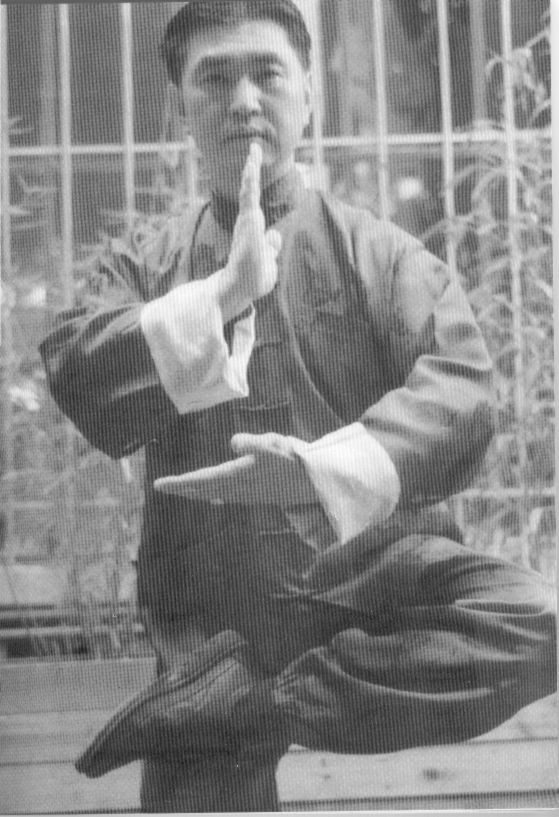

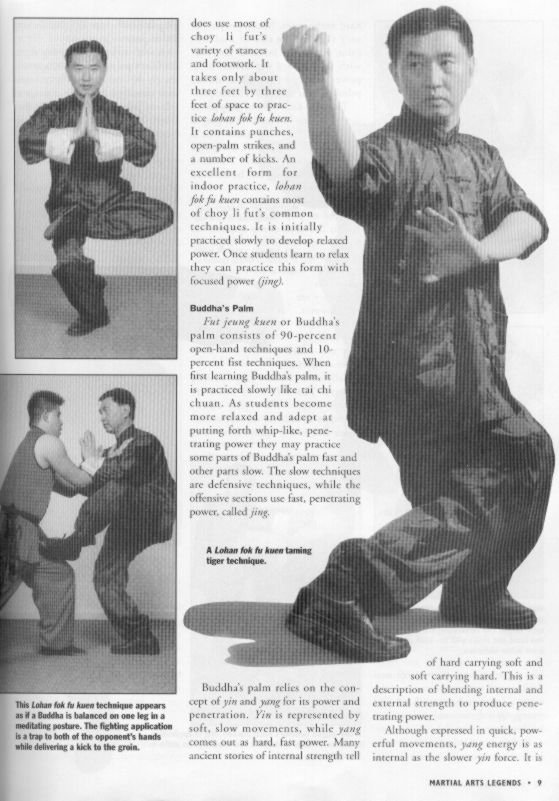
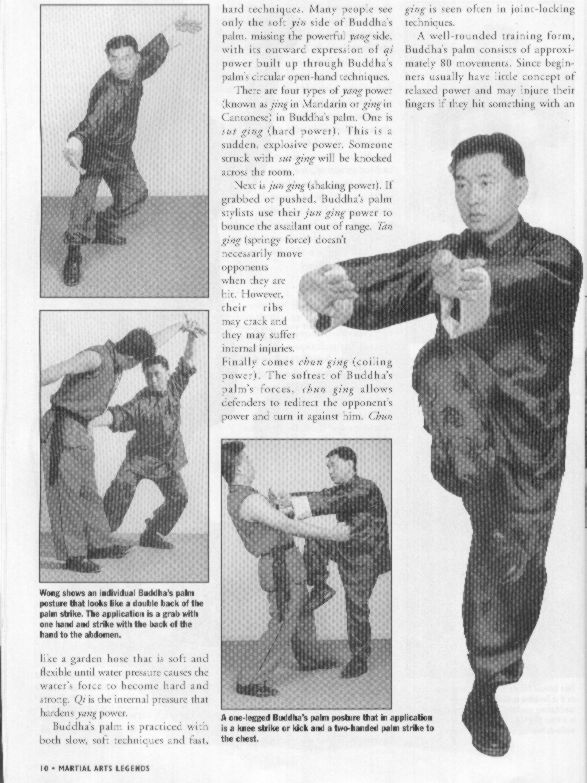
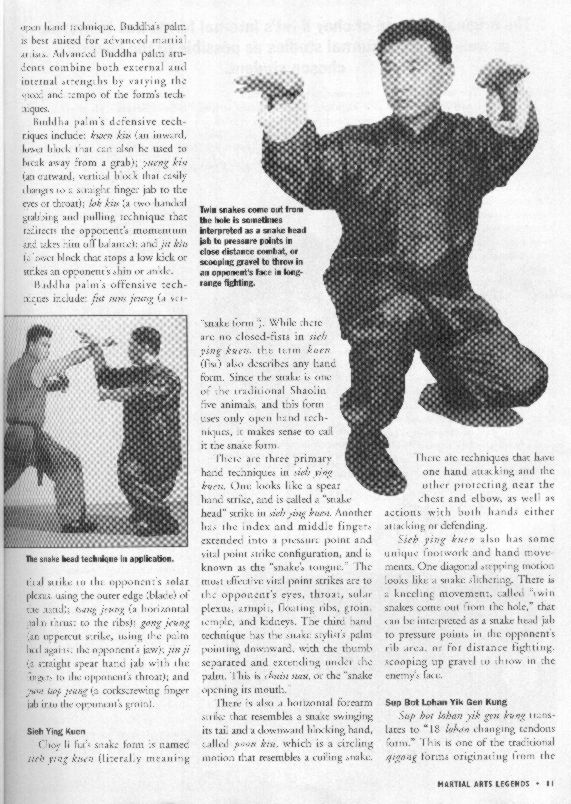
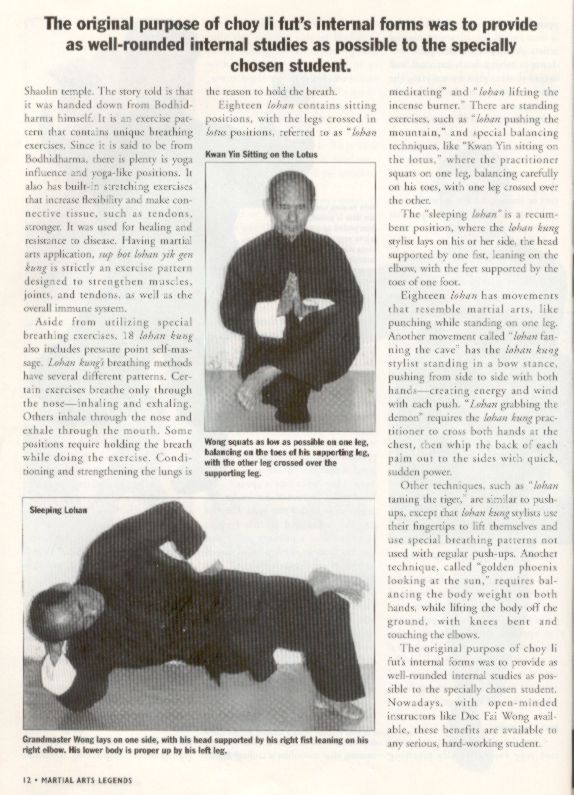
SOUTHERN CHINA HAS PRODUCED SOME OF THE WORLD'S most interesting martial arts. While generally considered external, strength, and speed oriented fighting styles, most Southern China martial arts also have their internal sides. For Choy Li Fut that means four separate internal forms, all tied together to produce a well-rounded internal stylist. In the China of the mid-1800s and early-1900s, internal techniques and forms were often kept a tight secret. Afraid that casual students might use the higher level martial art against the teacher himself, those who knew these forms taught them only to their most loyal and deserving students.
Choy Li Fut's internal forms all come from the kong chow school, through the system's founder's son, Chan On Pak. Chan On Pak passed these almost secretive forms on to his student, Chan Yen, who taught his own student, Wong Gong. Wong Gong, now a resident of Hong Kong, taught only a few people, one being Choy Li Fut Grandmaster Doc-Fai Wong, headquartered in San Francisco, California. Seeing no reason to keep forms that benefit students so much a secret, Wong teaches Choy Li Fut's internal forms to any of his students who have reached the level where they are able to understand the techniques.
In this group of internal patterns there are four forms that may also be used as training for defense and one form designed primarily for health purposes. The four fighting forms are Kwan Yin Palm, Lohan Fok Fu Kuen, Fut Jeung Kuen, and Sieh Ying Kuen. They are described below.
Kwan Yin Palm
Kwan Yin palm is unique because it has no footwork. It was devised as a self-defense training technique for people who are handicapped and unable to stand, or those who might be caught in a sitting position for self-defense purposes. There are 108 movements in kwan yin palm. All of the movements are hand techniques, with the majority being open-hand techniques. It is said that traditionally, Kwan Yin palm was used by the often-seated meditating monks of the Shaolin temple. Therefore, it was originally practiced with the stylist seated in a "lotus position." The many open-palm techniques are intended to resemble the commonly seen Kwan Yin statue, with many arms outstretched in a variety of different positions. Kwan Yin palm has a traditional reputation of developing spiritual power, however, each hand movement can be a powerful defensive or offensive technique, with some being joint locking techniques and pressure point strikes. Kwan Yin palm is practiced slowly, like tai chi chuan.
Lohan Fok Fu Kuen
Lohan fok fu kuen translates to disciples of Buddha taming the tiger. Lohan was a term of respect for very high-ranking Buddhist monks. The reason it is called "taming the tiger" is due to the many choy li fut "fighting tiger positions" in the form. This form doesn't take up much space, but does use most of Choy Li Fut's variety of stances and footwork. It takes only about three feet by three feet of space to practice lohan fok fu kuen. It contains punches, open-palm strikes, and a number of kicks. An excellent form for indoor practice, lohan fok fu kuen contains most of Choy Li Fut's common techniques. It is initially practiced slowly to develop relaxed power. Once students learn to relax they can practice this form with focused power (jing).
Buddha's Palm
Fut jeung kuen or Buddha's palm consists of 90-percent open-hand techniques and 10-percent fist techniques. When first learning Buddha's palm, it is practiced slowly like tai chi chuan. As students become more relaxed and adept at putting forth whip-like, penetrating power they may practice some parts of Buddha's palm fast and other parts slow. The slow techniques are defensive techniques, while the offensive sections use fast, penetrating power, called jing. Buddha's palm relies on the concept of yin and yang for its power and penetration. Yin is represented by soft, slow movements, while yang comes out as hard, fast power. Many ancient stories of internal strength tell of hard carrying soft and soft carrying hard. This is a description of blending internal and external strength to produce penetrating power.
Although expressed in quick, powerful movements, yang energy is as internal as the slower yin force. It is like a garden hose that is soft and flexible until water pressure causes the water's force to become hard and strong. Qi is the internal pressure that hardens yang power.
Buddha's palm is practiced with both slow, soft techniques and fast, hard techniques. Many people see only the soft yin side of Buddha's palm, missing the powerful yang side, with its outward expression of qi power built up through Buddha's palm's circular open-hand techniques.
There are four types of yang power (known as jing in Mandarin or ging in Cantonese) in Buddha's palm. One is sut ging (hard power). This is a sudden, explosive power. Someone struck with sut ging will be knocked across the room.
Next is jun ging (shaking power). If grabbed or pushed, Buddha's palm stylists use their jun ging power to bounce the assailant out of range. Tan ging (springy force) doesn't necessarily move opponents when they are hit. However, their ribs may crack and they may suffer internal injuries. Finally comes chun ging (coiling power). The softest of Buddha's palm's forces, chun ging allows defenders to redirect the opponent's power and turn it against him. Chun ging is seen often in joint-locking techniques.
A well-rounded training form, Buddha's palm consists of approximately 80 movements. Since beginners usually have little concept of relaxed power and may injure their fingers if they hit something with an open hand technique, Buddha's palm is best suited for advanced martial artists. Advanced Buddha palm students combine both external and internal strengths by varying the speed and tempo of the form's techniques.
Buddha palm's defensive techniques include: kwen kiu (an inward, lower block that can also be used to break away from a grab); yueng kiu (an outward, vertical block that easily changes to a straight finger jab to the eyes or throat); lok kiu (a two-handed grabbing and pulling technique that redirects the opponent's momentum and takes him offbalance); and jit kiu (a lower block that stops a low kick or strikes an opponent's shin or ankle.
Buddha palm's offensive techniques include: fut sum jeung (a vertical strike to rhe opponent's solar plexus, using the outer edge (blade) of the hand); tsang jeung (a horizontal palm thrust to the ribs); gong jeung (an uppercut strike, using the palm heel against the opponent's jaw); jin ji (a straight spear hand jab with the fingers to the opponent's throat); and yum tsop jeung (a corkscrewing finger jab into the opponent's groin).
Sieh Ying Kuen
Choy Li Fut's snake form is named sieh ying kuen (literally meaning "snake form"). While there are no closed-fists in sieh ying kuen, the term kuen (fist) also describes any hand form. Since the snake is one of the traditional Shaolin five animals, and this form uses only open hand techniques, it makes sense to call it the snake form.
There are three primary hand techniques in sieh ying kuen. One looks like a spear hand strike, and is called a "snake head" strike in sieh ying kuen. Another has the index and middle fingers extended into a pressure point and vital point strike configuration, and is known as the "snake's tongue." The most effective vital point strikes are to the opponent's eyes, throat, solar plexus, armpit, floating ribs, groin, temple, and kidneys. The third hand technique has the snake stylist's palm pointing downward, with the thumb separated and extending under the palm. This is chuin nau, or the "snake opening its mouth."
There is also a horizontal forearm strike that resembles a snake swinging its tail and a downward blocking hand, called poon kiu, which is a circling motion that resembles a coiling snake. There are techniques that have one hand attacking and the other protecting near the chest and elbow, as well as actions with both hands either attacking or defending.
Sieh ying kuen also has some unique footwork and hand movements. One diagonal stepping motion looks like a snake slithering. There is a kneeling movement, called "twin snakes come out from the hole," that can be interpreted as a snake head jab to pressure points in the opponent's rib area, or for distance fighting, scooping up gravel to throw in the enemy's face.
Sup Bot Lohan Yik Gen Kung
Sup bot lohan yik gen kung translates to "18 Lohan changing tendons form." This is one of the traditional qigong forms originating from the Shaolin temple. The story told is that it was handed down from Bodhidharma himself. It is an exercise pattern that contains unique breathing exercises. Since it is said to be from Bodhidharma, there is plenty is yoga influence and yoga-like positions. It also has built-in stretching exercises that increase flexibility and make connective tissue, such as tendons, stronger. It was used for healing and resistance to disease. Having martial arts application, sup bot lohan yik gen kung is strictly an exercise pattern designed to strengthen muscles, joints, and tendons, as well as the overall immune system.
Aside from utilizing special breathing exercises, 18 lohan kung also includes pressure point self-massage. Lohan kung's breathing methods have several different patterns. Certain exercises breathe only through the nose-inhaling and exhaling. Others inhale through the nose and exhale through the mouth. Some positions require holding the breath while doing the exercise. Conditioning and strengthening the lungs is the reason to hold the breath.
Eighteen lohan contains sitting positions, with the legs crossed in lotus positions, referred to as "lohan meditating" and "lohan lifting the incense burner." There are standing exercises, such as "lohan pushing the mountain," and special balancing techniques, like "Kwan Yin sitting on the lotus," where the practitioner squats on one leg, balancing carefully on his toes, with one leg crossed over the other.
The "sleeping lohan" is a recumbent position, where the lohan kung stylist lays on his or her side, the head supported by one fist, leaning on the elbow, with the feet supported by the toes of one foot.
Eighteen lohan has movements that resemble martial arts, like punching while standing on one leg. Another movement called" lohan fanning the cave" has the lohan kung stylist standing in a bow stance, pushing from side to side with both hands-creating energy and wind with each push. "Lohan grabbing the demon" requires the lohan kung practitioner to cross both hands at the chest, then whip the back of each palm out to the sides with quick, sudden power.
Other techniques, such as "lohan taming the tiger," are similar to push-ups, except that lohan kung stylists use their fingertips to lift themselves and use special breathing patterns not used with regular push-ups. Another technique, called "golden phoenix looking at the sun," requires balancing the body weight on both hands, while lifting the body off the ground, with knees bent and touching the elbows.
The original purpose of Choy Li Fut's internal forms was to provide as well-rounded internal studies as possible to the specially chosen student. Nowadays, with open-minded instructors like Doc Fai Wong available, these benefits are available to any serious, hard-working student.
Napisano Ponad rok temu
No bez propagandy !!! Bo nie ze wszystkim się zgadzam i zaraz się zacznie

Dawno mnie tu nie było ale widze ,że pewne tematy nie uległy przedawnieniu :wink:
Napisano Ponad rok temu
Dużo wklejonego tekstu
Dzięki za artykuł... poklon
Na pewno warto poczytać i porównać.
Pozdrawiam
Użytkownicy przeglądający ten temat: 1
0 użytkowników, 1 gości, 0 anonimowych
 FaceBook
FaceBook
10 następnych tematów
-
 chi mei gun
chi mei gun- Ponad rok temu
-
 jaki styl wybrac
jaki styl wybrac- Ponad rok temu
-
 Wnioski do moderatorów
Wnioski do moderatorów- Ponad rok temu
-
 Zamach na wolność naszą i waszą :)
Zamach na wolność naszą i waszą :)- Ponad rok temu
-
 Przyszłość kungfu
Przyszłość kungfu- Ponad rok temu
-
 Treningi Kung Fu dla dzieci szkolnych.
Treningi Kung Fu dla dzieci szkolnych.- Ponad rok temu
-
 Jak sie nazywa taki...
Jak sie nazywa taki...- Ponad rok temu
-
 Zaproszenie dla ekspertów
Zaproszenie dla ekspertów- Ponad rok temu
-
 Pokazy na Chinski Nowy Rok (clip)
Pokazy na Chinski Nowy Rok (clip)- Ponad rok temu
-
 porada o styl
porada o styl- Ponad rok temu





